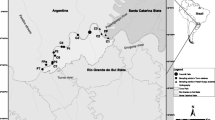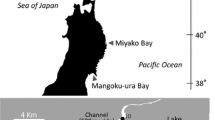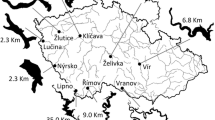Abstract
The effects of artificial water-level manipulations in Lake Biwa, initiated in 1992 to prevent flooding, on cyprinid fish larvae were assessed by measuring and estimating the topographic change in the reed zones. The shallow, litter-accumulated water in those zones was inhabited by larvae of two species, Carassius spp. and Cyprinus carpio. More than 70% (by volume) of these shallow areas in Lake Biwa was estimated to be lost when the water level was artificially lowered by 30cm from June to October 1997. During the low water level period, significantly fewer eggs of these cyprinid fishes were collected in a reed zone than in April and May of the same year, a comparison with a previous study suggesting that spawning of the fishes was inhibited during the period of low water level. The artificial reductions in water level probably resulted in a significant decrease in the volume of shallow water in the lake and may be linked to the drastic decline in these cyprinid fishes.
Similar content being viewed by others
References
Balon EK (1975) Reproductive guilds of fishes: a proposal and definition. J Fish Res Board Can 32:821–864
Biwako Bunkakan (1991) Fishes in Lake Biwa (in Japanese). Daiichi-Houki, Tokyo (in Japanese)
Burleson ML, Wilhelm DR, Smatresk NJ (2001) The influence of fish size on the avoidance of hypoxia and oxygen selection by largemouth bass. J Fish Biol 59:1336–1349
Dahlberg ML, Shurnway DL, Doudoroff P (1968) Influence of dissolved oxygen and carbon dioxide on swimming performance of largemouth bass and coho salmon. Can J Res Board Can 25:49–70
Davis JC (1975) Minimal dissolved oxygen requirements of aquatic life with emphasis on Canadian species: a review. Can J Fish Aquat Sci 32:2295–2332
Dolinskiy VL (1984) Fish fry in beds of aerial-aquatic plants. Hydrobiol J 19:86–91
Duncan A, Kubecka J (1995) Land/water ecotone effects in reservoirs on the fish fauna. Hydrobiologia 303:11–30
Fujiwara K (1996) Importance of reed zones as a nursery ground for round crucian carp (Carassius auratus grandoculis) (in Japanese). In: The 14th symposium of Lake Biwa research. Conservation of biota and ecosystems in mountain farm villages. Lake Biwa Research Institute, Shiga, pp 63–73
Fujiwara K, Usuki T, Mizutani E, Ujiie M (1994) Life history of larvae and juveniles of round crucian carp (Carassius auratus grandoculis) (in Japanese). Reports of Shiga Fisheries Experimental Station, Japan, pp 22-23
Gaboury MN, Patalas JW (1984) Influence of water level drawdown on the fish populations of Cross Lake, Manitoba. Can J Fish Aquat Sci 41:118–125
Gasith A, Gafny S (1990) Effects of water level fluctuation on the structure and function of the littoral zone. In: Tilzer MM, Serruya C (eds) Large lakes. Springer, Berlin, pp 156–171
Hikone Local Meteorological Observatory (1985-1997) Annual report of meteorology in Shiga Prefecture (in Japanese). Hikone Local Meteorological Observatory, Japan
Hirai K (1970) Ecological studies of fry and juvenile of fishes at aquatic plant areas in a bay of Lake Biwa. I: On the distribution of fish larvae (in Japanese with English abstract). Bull Dep Educ Kanazawa Univ 20:93–105
Hirai K (1972) Ecological studies of fry and juvenile of fishes at aquatic plant areas in a bay of Lake Biwa. III: Relationship of the food habits to the habitat of Nigoroguna (Carassius carassius glandoculis) larvae (in Japanese with English abstract). Jpn J Ecol 22:69–93
Hongjuan W, Chuanlin H (1995) Effects of summer water level on fish yield and plankton community in Heilingtan Reservoir (in Chinese with English abstract). Acta Hydrobiol Sin 19:360–367
Horie S (1984) Introduction of Lake Biwa. In: Horie S (ed) Lake Biwa. Junk, Dordrecht, pp 1–2
Hosoya K (1988) Cyprinidae. In: Okiyama M (ed) An atlas of the early stage fishes in Japan (in Japanese). Tokai University Press, Tokyo, pp 141–157
Hosoya K (1993) Cyprinidae. In: Nakabo T (ed) Fishes of Japan with pictorial keys to the species (in Japanese). Tokai University Press, Tokyo, pp 212–230
Il’ina LK, Gordeyev NA (1972) Water-level regime and the spawning of fish stocks in reservoirs. J Ichthyol 72:373–381
Itoh M (1992) The reed beds conservation ordinance of Lake Biwa. In: Isozaki H, Ando M, Natori Y (eds) Asian wetland symposium: towards wise use of Asian wetlands. International Lake Environmental Committee Foundation, Shiga, pp 145–151
Johnson FH (1956) Northern pike year-class strength and spring water levels. Trans Am Fish Soc 86:285–293
Kawanabe H, Mizuno N (1989) Freshwater fishes of Japan (in Japanese). Yama-kei, Tokyo
Kouhashi K, Iwasaki H (1993) Estimate of spawning amounts of warm temperature fishes in Yamanoshita Bay. Annual report. Shiga Fisheries Research Station, Japan, pp 47–48 (in Japanese)
Lachavanne J-B (1997) Why study biodiversity in land-inland water ecotones? In: Lachavanne J-B, Juge R (eds) Biodiversity in land-inland water ecotones. Parthenon, Paris, pp 1–45
Martin DB, Mengel LJ, Novotny JF, Walburg CH (1981) Spring and summer water level in a Missouri River reservoir: effects on age-0 fish and zooplankton. Trans Am Fish Soc 110:370–381
Miranda LE, Hodges KB (2000) Role of vegetation coverage on hypoxia and sunfish abundance in bays of a eutrophic reservoir. Hydrobiologia 427:51–57
Mitsch WJ, Gosselink JG (1993) Biogeochemistry of wetlands. In: Mitsch WJ, Gosselink JG (eds) Wetlands. Van Nostrand Reinhold, New York, pp 114–163
Moore WG (1942) Field studies on the oxygen requirements of certain fresh-water fishes. Ecology 23:319–329
Nakai K (1999) Recent faunal changes in Lake Biwa, with particular reference to the bass fishing boom in Japan. In: Kawanabe H, Coulter GW, Roosevelt AC (eds) Ancient lakes: their cultural and biological diversity. Kenobi, Ghent, pp 227–241
Nakajima T (1994) The natural history of Lake Biwa. Yasaka Shobo, Tokyo
Nakamura M (1969) Cyprinid fishes of Japan (in Japanese). Special publication. Research Institute for Natural Resources, Tokyo
Nilsson C, Jansson R, Zinko U (1997) Long-term responses of river-margin vegetation to water-level regulation. Science 276:798–800
Odum EP (1971) Fundamentals of ecology. Saunders, Philadelphia
Rozas LP, Odum WE (1988) Occupation of submerged aquatic vegetation by fishes: testing the roles of food and refuge. Oecologia (Berl) 77:101–106
Shiga Statistics Association of Agricultural and Forestry (1991-1997) Statistics yearbook of agriculture, forestry and fisheries, Shiga Prefecture (in Japanese). Shiga Statistics Association of Agricultural and Forestry, Japan
Wilcox DA, Meeker JE (1992) Implications for faunal habitat related to altered macrophyte structure in regulated lakes in northern Minnesota. Wetlands 12:192–203
Yamanaka O (1989) Food habits of Micropterus salmoides (in Japanese). Scientific reports. Shiga Fisheries Experimental Station, Japan, pp 20–83
Yamamoto T, Nozaki K (2004) Microcrustacean abundance as potential food resources for larval and juvenile fishes in a reed zone of Lake Biwa. Suisanzoshoku 52:145–152
Yuma M, Hosoya K, Nagata Y (1998) Distribution of freshwater fishes of Japan: an historical overview. Environ Biol Fishes 52:97–124
Author information
Authors and Affiliations
Corresponding author
Rights and permissions
About this article
Cite this article
Yamamoto, T., Kohmatsu, Y. & Yuma, M. Effects of summer drawdown on cyprinid fish larvae in Lake Biwa, Japan. Limnology 7, 75–82 (2006). https://doi.org/10.1007/s10201-006-0172-2
Received:
Accepted:
Published:
Issue Date:
DOI: https://doi.org/10.1007/s10201-006-0172-2




